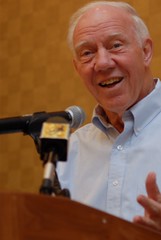“Over reliance on automobiles can have adverse impacts on public health, both through lessened physical activity and from increased pollutants.”
— from the bill’s description of the Office of Livability
U.S. Rep. Jim Oberstar, Chairman of the House Transportation and Infrastructure Committee has released the full text of the federal transportation bill. Calling it the “Surface Transportation Authorization Act of 2009,” the 775-page document lays out every facet of how the United States manages its transportation system.
Last week we speculated what the bill might include and now we’ve got the real deal. I’ve been combing through it and looking for bike-related bits. So far, the most interesting section is the full description of the new Office of Livability.
If established as drafted in this bill, this new Office could be a very exciting step for biking in America.
The 20-page description of the Office of Livability begins by laying out the case against the status quo:
“Since the creation of the Interstate System, American surface transportation has been defined by the use of personal motor vehicles. The focus on automobiles has afforded Americans increased mobility and interconnectivity; yet has also lead to increased congestion, higher greenhouse gas emissions, and a reduced focus onother modes of surface transportation.”
I’d say given what “the focus on automobiles” has done to this country, that’s putting it nicely. The bill then backs up some of those claims:
“Between 1955 and 2005, vehicle miles traveled in the United States increased fivefold, bringing with it an escalation in traffic congestion.
Each year, Americans spend 4,200,000,000 hours in traffic congestion, burning 2,900,000,000 gallons of fuel.
Wasted time and fuel result in a $78,000,000,000 annual congestion tax, creating a financial drain on individual passengers and the economy as a whole.
…Over reliance on automobiles can have adverse impacts on public health, both through lessened physical activity and from increased pollutants.”
Then the bill makes the case for non-highway modes:
“Public transit, walking, and cycling are sustainable modes of transportation that result in 5,600,000,000 gallons of fuel savings and reduce carbon dioxide emissions by 49,000,000 metric tons each year.
Sustainable modes of transportation can provide affordable transportation choices and have the ability to reduce the transportation cost burden.”
After that, there’s a phrase I’ve never heard before. The bill refers to “cyclists and pedestrians” as “intended users” (I love this because it makes the point that the current system is not intended for people who walk and bike):
“Cyclists and pedestrians are intended users of the surface transportation system, except where prohibited by law; and it is the policy of the Federal Government to encourage maximum accessibility and safety of the surface transportation system for cyclists and pedestrians as intended users when designing and constructing surface transportation facilities.”
(If this passes, I want a T-shirt that has “Intended User!” emblazoned on the back.)
After the introduction, the bill describes what roles the Director of the Office of Livability (wonder who will be picked for that post?) would be responsible for. Among the expected oversight duties (like Transportation Enhancements, Safe Routes to Schools, and other bike-related programs), there are some new ones that reflect Oberstar’s understanding of where major gaps remain in strengthening the role of the bicycle in American life.
The Office of Livability would manage the “Development of statistical and analytic capabilities.” The office would oversee research to determine things like the percentage of trips taken nationally for transit, motor vehicles and walking and biking; and the economic, public health, and environmental benefits of “sustainable modes of transportation.”
Better research to combat the auto-centric paradigm has been on everyone’s mind lately. Bikes Belong recently hosted a summit of bike researchers and U.S. Rep. Earl Blumenauer has said better research is one of his top priorities.
“The Director [of the Office of Livability] shall conduct a study on whether State and local laws and the actions of judicial systems are affording cyclists and pedestrians who are injured or suffer property damage… the same ability to recover damages… as would be available to persons in motor vehicles.”
— from the bill text
Perhaps the most surprising find so far in the bill text is that it directs the leader of the Office of Livability to conduct a study on the rights of cyclists and pedestrians. Back in March, I hinted that Oberstar was interested in this topic, so it’s neat to see it come to life in the official bill.
As written, the bill says the study should look into how (or if) state and local laws deal with the, “rights of cyclists and pedestrians to use transportation facilities and to be intended and permitted users of these facilities”. The study would also look into whether state/local laws and the courts “are affording cyclists and pedestrians who are injured in collisions, “the same ability to recover damages for their injuries as would be available to persons in motor vehicles suffering comparable injuries.”
The Office of Livability would also be directed to report back to Congress with results from the study and recommendations on how to improve the laws for people who walk and bike.
There’s a long road ahead for this bill and there are no funding numbers attached yet. But, at first glance, it seems to include some big wins for biking.
Stay tuned for more coverage.
Download the full bill over at Transportation for America.


